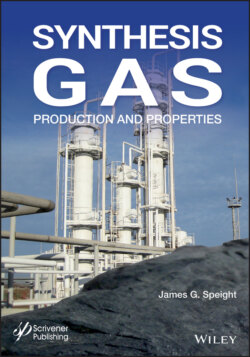Читать книгу Synthesis Gas - James Speight G., James G. Speight - Страница 53
2.5.5.5 Hydrogasification
ОглавлениеNot all high heat-content (high-Btu) gasification technologies depend entirely on catalytic methanation and, in fact, a number of gasification processes use hydrogasification, that is, the direct addition of hydrogen to feedstock under pressure to form methane.
The hydrogen-rich gas for hydrogasification can be manufactured from steam and char from the hydrogasifier. Appreciable quantities of methane are formed directly in the primary gasifier and the heat released by methane formation is at a sufficiently high temperature to be used in the steam-carbon reaction to produce hydrogen so that less oxygen is used to produce heat for the steam-carbon reaction. Hence, less heat is lost in the low-temperature methanation step, thereby leading to higher overall process efficiency.
Hydrogasification is the gasification of feedstock in the presence of an atmosphere of hydrogen under pressure. Thus, not all high heat-content (high-Btu) gasification technologies depend entirely on catalytic methanation and, in fact, a number of gasification processes use hydrogasification, that is, the direct addition of hydrogen to feedstock under pressure to form methane:
The hydrogen-rich gas for hydrogasification can be manufactured from steam by using the char that leaves the hydrogasifier. Appreciable quantities of methane are formed directly in the primary gasifier and the heat released by methane formation is at a sufficiently high temperature to be used in the steam-carbon reaction to produce hydrogen so that less oxygen is used to produce heat for the steam-carbon reaction. Hence, less heat is lost in the low-temperature methanation step, thereby leading to higher overall process efficiency.
The hydrogasification reaction is exothermic and is thermodynamically favored at low temperatures (<670°C, <1240oF), unlike the endothermic both steam gasification and carbon dioxide gasification reactions. However, at low temperatures, the reaction rate is inevitably too slow. Therefore, a high temperature is always required for kinetic reasons, which in turn requires high pressure of hydrogen, which is also preferred from equilibrium considerations. This reaction can be catalyzed by salts such as potassium carbonate (K2CO3), nickel chloride (NiCl2), iron chloride (FeCl2), and iron sulfate (FeSO4). However, use of a catalyst in feedstock gasification suffers from difficulty in recovering and reusing the catalyst and the potential for the spent catalyst becoming an environmental issue.
In a hydrogen atmosphere at elevated pressure, additional yields of methane or other low molecular weight hydrocarbon derivatives can result during the initial feedstock gasification stage from direct hydrogenation of feedstock or semi-char because of active intermediate formed in the feedstock structure after pyrolysis. The direct hydrogenation can also increase the amount of feedstock carbon that is gasified as well as the hydrogenation of gaseous hydrocarbon derivatives, oil, and tar.
The kinetics of the rapid-rate reaction between gaseous hydrogen and the active intermediate depends on hydrogen partial pressure (PH2). Greatly increased gaseous hydrocarbon derivatives produced during the initial feedstock gasification stage are extremely important in processes to convert feedstock into methane (SNG, synthetic natural gas, substitute natural gas).
